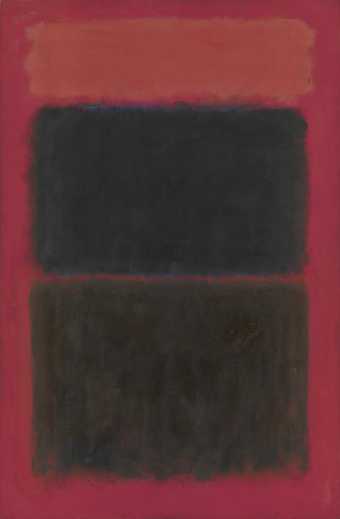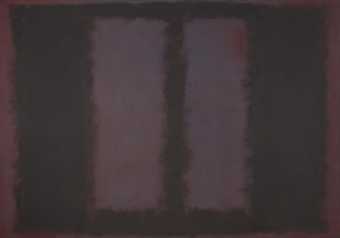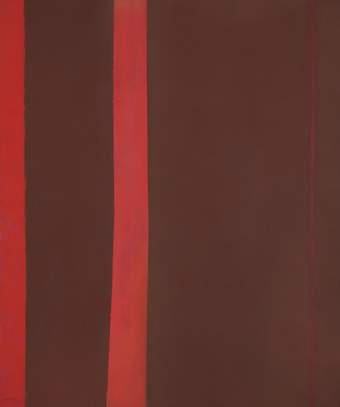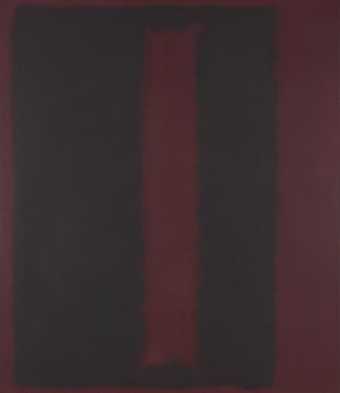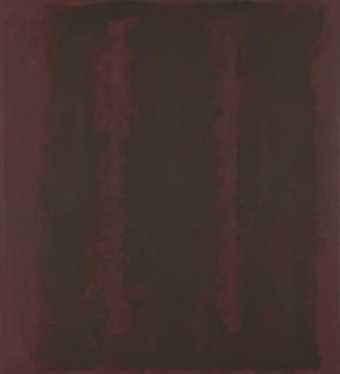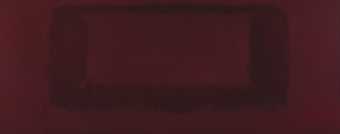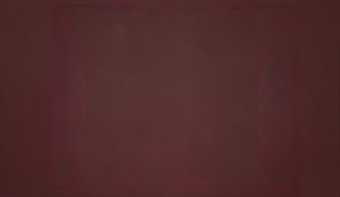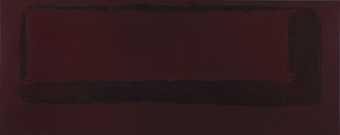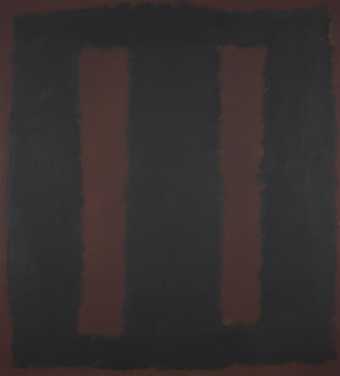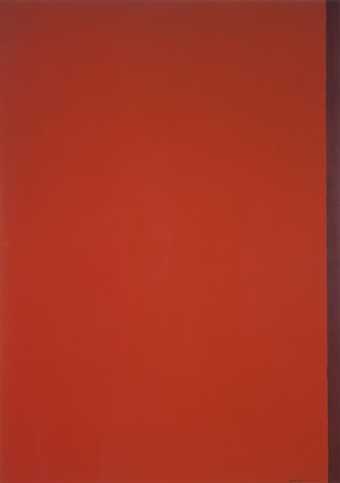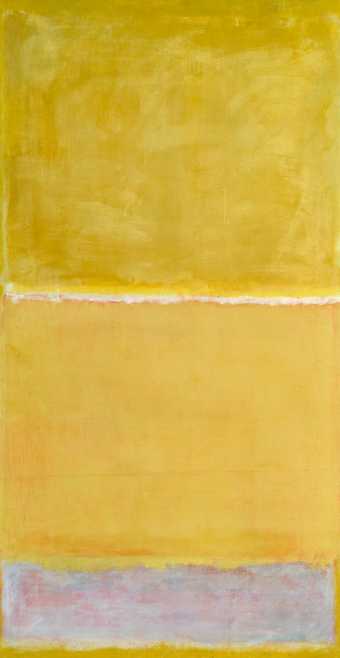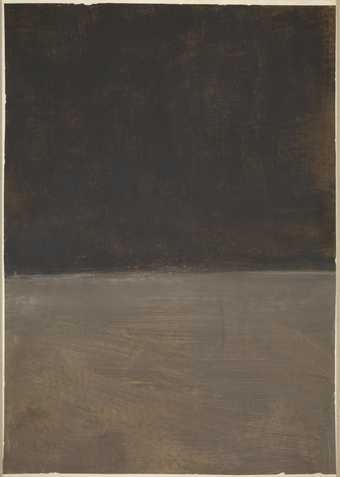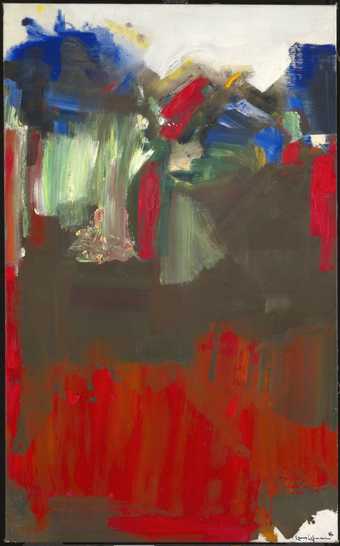
Not on display
- Artist
- Mark Rothko 1903–1970
- Medium
- Oil paint, acrylic paint and glue tempera on canvas
- Dimensions
- Support: 2667 × 2388 × 35 mm
- Collection
- Tate
- Acquisition
- Presented by the artist through the American Federation of Arts 1969
- Reference
- T01165
Summary
Red on Maroon is a large unframed oil painting on a vertically orientated rectangular canvas. The base colour of the painting is a muted maroon. As is suggested by the work’s title, this is overlaid with a large red rectangle, which in turn encloses a narrower maroon rectangle, suggesting a window-like structure. The red paint forms a solid block of colour but the edges seep slightly, blurring into the areas of maroon. Different pigments have been used within the maroon, blending shades of crimson and mauve colour. This changing tone gives a sense of depth in an otherwise abstract composition.
Red on Maroon was painted by the abstract expressionist artist Mark Rothko. He is best known, alongside fellow Americans Barnett Newman and Robert Motherwell, as a pioneer of colour field painting. The movement was characterised by simplified compositions of unbroken colour, which produced a flat picture plane. Red on Maroon was painted on a single sheet of tightly stretched cotton duck canvas. The canvas was primed with a base coat of maroon paint, made from powder pigments mixed into rabbit skin glue. The glue within the paint shrank as it dried, giving the painting’s surface its matt finish. Onto the base Rothko added a second coat that he subsequently scraped away to leave a thin coating of colour. The red paint was then added in fast, broken brushstrokes, using a large commercial decorator’s brush. With broad sweeping gestures Rothko spread the paint onto the canvas surface, muddying the edges between the blocks of colour, creating a sense of movement and depth. With time this difference has become more pronounced as the pigments fade at varying rates.
In early 1958 Rothko was commissioned to paint a series of murals for the exclusive Four Seasons restaurant in the Seagram Building in New York, designed by Mies van der Rohe and Philip Johnson. Rothko was interested in the possibility of having a lasting setting for his paintings to be seen as a group. He wanted to create an encompassing environment of the sort he had encountered when visiting Michelangelo’s vestibule in the Laurentian Library in Florence in 1950 and again in 1959:
I was much influenced subconsciously by Michelangelo’s walls in the staircase room of the Medicean Library in Florence. He achieved just the kind of feeling I’m after – he makes the viewers feel that they are trapped in a room where all the doors and windows are bricked up, so that all they can do is butt their heads forever against the wall.
(Quoted in Breslin 2012, p.400.)
Rothko started work on the Seagram commission in a large new studio, which allowed him to simulate the restaurant’s private dining room. Between 1958 and 1959 Rothko created three series of paintings, but was unsatisfied with the first and sold these paintings as individual panels. In the second and third series Rothko experimented with varying permutations of the floating window frame and moved towards a more sombre colour palette, to counter the perception that his work was decorative. Red on Maroon belongs to the third series, in which the blocks of colour within the works had become more defined. By the time Rothko had completed these works he had developed doubts about the appropriateness of the restaurant setting, which led to his withdrawal from the commission. However, this group of works is still referred to as the ‘Seagram Murals’.
The works were shown at Rothko’s 1961 retrospective at the Whitechapel Art Gallery in London, and in 1965 Norman Reid, then Director of Tate, approached Rothko about extending his representation in the gallery’s collection. Rothko suggested a group of paintings from the ‘Seagram Murals’, to be displayed in a dedicated room. Rothko’s first donation, the earlier Black on Maroon 1958 (Tate T01031), came in 1968. The following year Reid provided Rothko with a small cardboard maquette of the designated gallery space to finalise his selection and propose a hang. (This maquette is now in Tate’s Archive, TGA 872, and is reproduced in Borchardt-Hume 2008, pp.143–5.) Rothko then donated eight further paintings in 1969, including this one, and of these eight, four are titled Red on Maroon and four Black on Maroon (Tate T01163–T01170). The ‘Seagram Murals’ have since been displayed almost continuously at Tate, albeit in different arrangements, in what is commonly termed the ‘Rothko Room’ (for installation views see Borchardt-Hume 2008, pp.98, 142).
Further reading
Simon Wilson, Tate Gallery: An Illustrated Companion, London 1991.
Achim Borchardt-Hume (ed.), Rothko: The Late Series, exhibition catalogue, Tate Modern, London 2008, reproduced p.129.
James Breslin, Mark Rothko: A Biography, Chicago 2012.
Phoebe Roberts
May 2016
Supported by the Terra Foundation for American Art.
Does this text contain inaccurate information or language that you feel we should improve or change? We would like to hear from you.
Display caption
This is one of a series of large paintings Rothko made for a fashionable New York restaurant. By layering the paint, he created subtle relationships between the muted colours. They are much darker in mood than his previous works. He was influenced by the atmosphere of a library designed by the Italian artist Michelangelo (1475–1564). Rothko recalled the feeling of being ‘trapped in a room where all the doors and windows are bricked up’. A restaurant, he decided, was the wrong setting for these paintings. Instead, he presented the series to Tate gallery.
Gallery label, June 2020
Does this text contain inaccurate information or language that you feel we should improve or change? We would like to hear from you.
Catalogue entry
Mark Rothko 1903-1970
T01165 Red on Maroon
1959
Inscribed on back of canvas 'MARK ROTHKO | 1958 [crossed out] | 1959' and (the other way up) '1958'
Oil on canvas, 105 x 94 (266.5 x 239)
Presented by the artist through the American Federation of Arts 1969
Exh:
Mark Rothko, Museum of Modern Art, New York, January-March 1961 (works not numbered, as 'Mural, Section 4, 1959'); Whitechapel Art Gallery, London, October-November 1961 (41, repr.); Stedelijk Museum, Amsterdam, November-December 1961 (41); Palais des Beaux-Arts, Brussels, January 1962 (41); Kunsthalle, Basle, March-April 1962 (42); Galleria Nazionale d'Arte Moderna, Rome, April-May 1962 (42, repr.); Musée d'Art Moderne de la Ville de Paris, December 1962-January 1963 (37)
Repr:
Terry Measham, The Moderns 1945-75
(Oxford 1976), pl.17 in colour
See the note on T01031. This picture has also been known as 'Mural, Section 4'.
Published in:
Ronald Alley, Catalogue of the Tate Gallery's Collection of Modern Art other than Works by British Artists, Tate Gallery and Sotheby Parke-Bernet, London 1981, p.662, reproduced p.662
Film and audio
Explore
- abstraction(8,615)
-
- non-representational(6,161)
-
- colour(2,481)
- emotions and human qualities(5,345)
-
- contemplation(141)
- pessimism(45)
You might like
-
Mark Rothko Light Red Over Black
1957 -
Mark Rothko Black on Maroon
1958 -
Barnett Newman Adam
1951, 1952 -
Mark Rothko Black on Maroon
1959 -
Mark Rothko Black on Maroon
1959 -
Mark Rothko Black on Maroon
1958 -
Mark Rothko Red on Maroon
1959 -
Mark Rothko Red on Maroon
1959 -
Mark Rothko Red on Maroon
1959 -
Mark Rothko Black on Maroon
1958 -
Barnett Newman Eve
1950 -
Mark Rothko Untitled
c.1946–7 -
Mark Rothko Untitled
c.1950–2 -
Mark Rothko Untitled
1969 -
Hans Hofmann Nulli Secundus
1964

